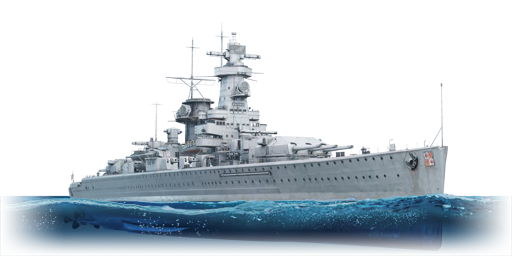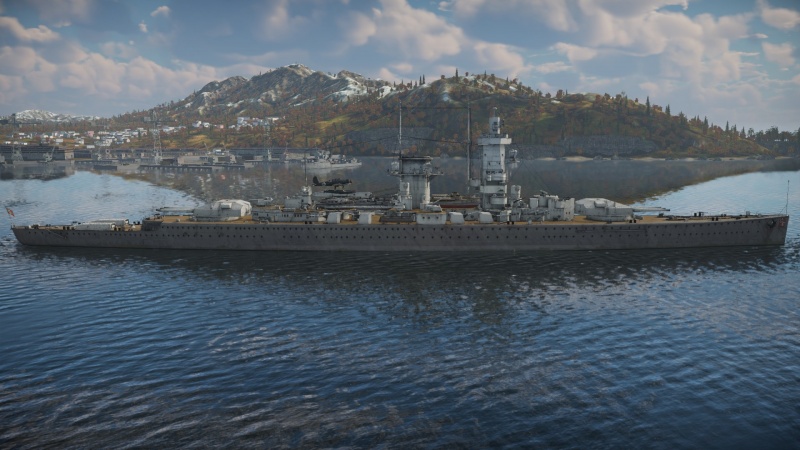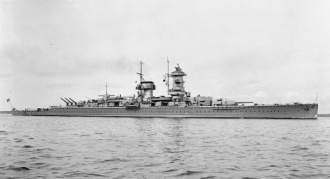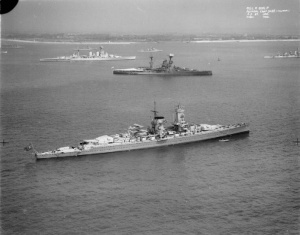Admiral Graf Spee
Contents
Description
The Deutschland-class, Admiral Graf Spee, 1939 is a rank German heavy cruiser
with a battle rating of (AB), (RB), and (SB). It was introduced in Update 1.95 "Northern Wind".
General info
Survivability and armour
Talk about the vehicle's armour. Note the most well-defended and most vulnerable zones, e.g. the ammo magazine. Evaluate the composition of components and assemblies responsible for movement and manoeuvrability. Evaluate the survivability of the primary and secondary armaments separately. Don't forget to mention the size of the crew, which plays an important role in fleet mechanics. Save tips on preserving survivability for the "Usage in battles" section. If necessary, use a graphical template to show the most well-protected or most vulnerable points in the armour.
Mobility
Write about the ship's mobility. Evaluate its power and manoeuvrability, rudder rerouting speed, stopping speed at full tilt, with its maximum forward and reverse speed.
| Mobility Characteristics | |||
|---|---|---|---|
| Game Mode | Upgrade Status | Maximum Speed (km/h) | |
| Forward | Reverse | ||
| AB | |||
| Upgraded | |||
| RB/SB | |||
| Upgraded | |||
Modifications and economy
Armament
Primary armament
Provide information about the characteristics of the primary armament. Evaluate their efficacy in battle based on their reload speed, ballistics and the capacity of their shells. Add a link to the main article about the weapon: {{main|Weapon name (calibre)}}. Broadly describe the ammunition available for the primary armament, and provide recommendations on how to use it and which ammunition to choose.
Secondary armament
Some ships are fitted with weapons of various calibres. Secondary armaments are defined as weapons chosen with the control Select secondary weapon. Evaluate the secondary armaments and give advice on how to use them. Describe the ammunition available for the secondary armament. Provide recommendations on how to use them and which ammunition to choose. Remember that any anti-air armament, even heavy calibre weapons, belong in the next section. If there is no secondary armament, remove this section.
Anti-aircraft armament
An important part of the ship's armament responsible for air defence. Anti-aircraft armament is defined by the weapon chosen with the control Select anti-aircraft weapons. Talk about the ship's anti-air cannons and machine guns, the number of guns and their positions, their effective range, and about their overall effectiveness – including against surface targets. If there are no anti-aircraft armaments, remove this section.
Torpedo armament
Torpedo launchers are standard equipment on many ships and boats. Torpedoes are a significant means of defeating an opponent. Evaluate the position of the torpedo launchers, discuss the ammunition available, firing specifics such as dead zones, features of the torpedoes themselves, etc. If there is no torpedo armament, remove this section.
Additional armament
Describe the available additional armaments of the ship: depth charges, mines, torpedoes. Talk about their positions, available ammunition and launch features such as dead zones of torpedoes.
If there is no additional armament, remove this section.
Usage in battles
Describe the technique of using this ship, the characteristics of her use in a team and tips on strategy. Abstain from writing an entire guide – don't try to provide a single point of view, but give the reader food for thought. Talk about the most dangerous opponents for this vehicle and provide recommendations on fighting them. If necessary, note the specifics of playing with this vehicle in various modes (AB, RB, SB).
Modules
| Tier | Seakeeping | Unsinkability | Firepower | |||
|---|---|---|---|---|---|---|
| I | Dry-Docking | Tool Set | 283 mm Psgr L/3.7 APBC | 15 cm Spgr. L/4.4 Bdz (m.Hb) | Anti-Air Armament Targeting | |
| II | Rudder Replacement | Fire Protection System | Smokescreen | 283 mm Spgr L/4.2 Bdz SAP | Auxiliary Armament Targeting | |
| III | Propeller Replacement | Shrapnel Protection | Ventilation | Improved Rangefinder | 15 cm Pzgr. L/3.7 (m.Hb) | Primary Armament Targeting |
| IV | Engine Maintenance | New Pumps | Ammo Wetting | Torpedo Mode | ||
Pros and cons
Pros:
- Fully armed with cannons for all purposes
- Biggest main gun calibre in game with a turret at each end of the ship with 3 x 280 mm cannons each
- Devastating HE shells with 30 kg of explosives
- High penetrating AP shells
- Thick armour that can resist HE shells
- Decent number of 88 mm AA cannons with fused HE for air units and 105 mm cannons for smaller ships
Cons:
- Big targets for enemy bombs and torpedoes
- 280 mm cannons have a long reload time
- Armour can be easily defeated with AP shells
History
The Admiral Graf Spee was a ship of the Deutschland class, a series of 10-thousand ton cruisers built to the limitations of the Treaty of Versailles. Despite her small tonnage, the Graf Spee was armed with six 11-inch (283 mm) main guns in two triple turrets, a much more powerful armament than its allied counterparts. As a result, the ships of the Deutschland class were nicknamed "Pocket Battleships" by the UK, and "Panzerschiff" (armoured ship) within the Kriegsmarine.[1] The ship conducted several patrols near Spain during the Spanish Civil War, and participated in the Coronation Review of King George VI. The ship was responsible for the sinking of 9 merchant vessels during the first months of the Second World War, before being intercepted by a task force of the British Navy at the River Plate. Having caused extensive damage to her pursuers but damaged herself, the Graf Spee was scuttled in the mouth of the River Plate on December 17th 1939.[2]
Design and construction
Following Germany's defeat in the First World War and the Treaty of Versailles, the Kriegsmarine was limited to a force of pre-dreadnought battleships and cruisers, with a 10-thousand tonne limit on new vessels. In the early 1920s, the German naval ministry started working on a new design of ships that could replace its ageing pre-dreadnoughts. Initially, designs included a slow, heavily armed "monitor"-type vessel, as well as a faster "heavy-cruiser" type design. Following several years of changes, a final design was adopted featuring six 283 mm guns in two 3-gun turrets.[3] Despite some initial opposition from the victorious powers (the United Kingdom, United States and France), the ships were allowed to be built as they did not violate the Treaty of Versailles.
The new Deutschland-class ships were named "Panzerschiffs", or "Armoured Ships". However, they would soon become known as the "Pocket Battleship". Though they were of similar size to their counterparts (like the British County-class cruisers), the ships carried a much more powerful armament and had greater armour protection.[3] The vessels displaced between 11,500 and 12,500 tonnes (though it was stated in public that they were 10-thousand tonnes only) standard, and up to 16,000 tonnes full load.[1] Armament consisted of six 11-inch guns in two triple turrets, as well as a secondary armament of eight 5.9-inch guns in single turrets.[1] The ship was capable of making 26 knots (48 km/h) and had a main armour belt of 100 mm thickness.[1]
Three Deutschland-class ships were built: Deutschland (later Lutzow), Admiral Scheer, and Admiral Graf Spee. The Graf Spee was ordered as Panzerschiff C and was laid down in 1932.[3] It replaced the old pre-dreadnought Braunschweig and was named after Admiral Maximilian von Spee.[3] The ship was launched in 1934, and was christened by the daughter of Von Spee. The ship was formally commissioned into the German Fleet on January 6th, 1936.[3]
Service history
Following its commissioning, the ship became the flagship of the German fleet. The ship participated in several non-intervention patrols off of the coast of Spain, and later represented Germany at King George VI's Coronation Review. The vessel also participated in several goodwill visits during the period of 1936-1938.[3]
Prior to the start of the Second World War, the Graf Spee sailed into the Southern Atlantic to be in the best position for commerce raiding. On September 26th 1939, the Graf Spee was ordered to commence raiding against allied merchantmen in the southern Atlantic. Four days later, the cruiser located and captured the TSS Clement,[4] which was sunk using gunfire and torpedoes. As a result, a formidable task force was put together to locate and destroy the Spee; this consisted of the carriers HMS Hermes, Eagle, Ark Royal, and Bearn (of the French navy), the battleships Dunkerque, Strasbourg (both of the French Navy), and HMS Renown, as well as 16 cruisers.[3]
The task force initially failed to locate the Spee, allowing her to destroy eight more merchantmen. This brought her total tonnage destroyed to 50,089 tonnes. However, the last Merchantmen was able to signal the Spee's location to the Allies - as a result, the cruisers HMS Exeter, Ajax, and Achilles were sent to intercept the ship.[4]
Battle of the River Plate and Scuttling
On the morning of December 5th 1939, a ship was sighted across the Graf Spee's starboard bow. This was the cruiser Exeter, actively searching for the Spee.[2] The Graf Spee proceeded to close in and open fire, while the British cruisers immediately returned fire with their main batteries. In the span of a few hours, the Graf Spee was able to inflict heavy damage on all three cruisers, especially the Exeter, who received extensive damage: all four of her main battery turrets were knocked out, as well as the bridge and torpedo tubes.[4] Having been hit with numerous 11-inch shells, the ship was burning and developed a list due to extensive flooding. However, a strong defence was put up by cruisers Ajax and Achilles, allowing the crippled cruiser to make it to the Falkland Islands for repairs.
Nonetheless, the British cruisers succeeded in crippling the Graf Spee - a single 8-inch shell from Exeter hit the engine compartment and disabled the ship's diesel cleaning system. As a result, the ship had just 16 hours of ready fuel, eliminating her chances of returning home.[3] Shadowed by Achilles and Ajax, the damaged Graf Spee docked at the neutral port of Montevideo to conduct repairs, repatriate prisoners, and obtain medical attention for injured crewmembers. However, because of the neutrality agreements of the Hague Convention, the ship was only able to dock for 72 hours. During this time, Allied intelligence tricked the Germans into thinking that a superior Allied force was located outside the bay, including the battlecruiser Renown and carrier Ark Royal.[3] In fact, only the heavy cruiser HMS Cumberland had arrived, as the reinforcement force would not be able to arrive for another week.[3]
The deceiving news of British reinforcements was a fatal blow to the Graf Spee. After considering their options and discussing with the high command in Germany, the decision was made to scuttle the ship, as the Graf Spee's damage and insufficient ammunition would prevent her from breaking out.[2] On December 17th, the Graf Spee was scuttled in the River Plate estuary. Three days later, her captain committed suicide in full uniform over the Graf Spee's battle ensign.[2] The remainder of the crew were interned in Uruguay for the duration of the war, while the ship was partially broken up on site between 1942 and 1943.
Media
See also
Links to articles on the War Thunder Wiki that you think will be useful for the reader, for example:
- reference to the series of the ship;
- links to approximate analogues of other nations and research trees.
External links
References
Bibliography
- Wiki Team. (2020). German cruiser Admiral Graf Spee. Retrieved November 13, 2020. Website
- Tikannen, A. (2020). Graf Spee. Retrieved November 13, 2020. Website
- Hickman, K. (2019, October 2). Pocket Battleship: Admiral Graf Spee. Retrieved November 13, 2020. Website
- McGibbon, I. (2014, November 27). Battle of the River Plate. Retrieved November 13, 2020. Website
| Germany heavy cruisers | |
|---|---|
| Admiral Hipper-class | Admiral Hipper · Prinz Eugen |
| Deutschland-class | Admiral Graf Spee |








